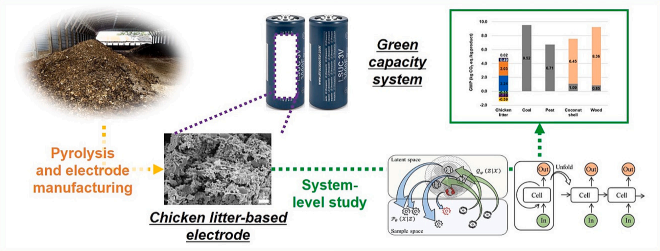
연구
Research Outcome
미래를 창조하는 포스텍 화학공학과
Environmentally-viable Utilization of Chicken Litter as Energy Recovery and Electrode Production: A Machine Learning Approach
- Title of paper
- Environmentally-viable Utilization of Chicken Litter as Energy Recovery and Electrode Production: A Machine Learning Approach
- Author
- [한지훈교수 연구실] 에너지 저장용 전극의 환경 친화적 생산 및 활용: 머신러닝 접근법 개발
- Publication in journal
- Applied Energy
- Publication date
- 20231115

[Abstract]
Waste-to-energy could eventually be a crucial role in new disposal strategy for organic waste like chicken litter. Herein, a pyrolysis-based process that fully utilize the pyrolysates of chicken litter as energy sources (gas and liquid fuels) and energy storage material (supercapacitor (SC) electrode), which significantly contributes to carbon neutrality, has been proposed. Feasibility and readiness of the proposed process were estimated by combining various approaches such as lab-scale experiment, full-scale process simulation, life cycle analysis, and machine learning. Pyrolytic products other than the SC electrode material, such as gas and liquid, could be considered as fuels given their higher heating values ranging from 6 to 7 MJ kg−1. The SC electrode is comprised of porous carbon and delivers a large specific capacitance of 90 F g−1 at a constant specific current of 0.1 A g−1, demonstrating a potential for use in energy storage. Compared with fossil-based electrode materials, the chicken litter-based electrode material had 49%–64% reduction in global warming potential (GWP) and 83% of abiotic depletion of fossil fuels. The implementation of an SC system using the chicken litter-derived electrode therefore has potential to reduce global warming and fossil resource depletion. In addition, a case study on Jeju Island in the Republic of Korea incorporating renewable energy networks was considered based on diverse samples and their forecasts from machine learning algorithms. The chicken litter-based SC system in Jeju Island could reduce 63,191 t CO2 eq. per year of GWP.
DOI: https://doi.org/10.1016/j.apenergy.2023.121782
link: https://www.sciencedirect.com/science/article/pii/S0306261923011467?via%3Dihub



